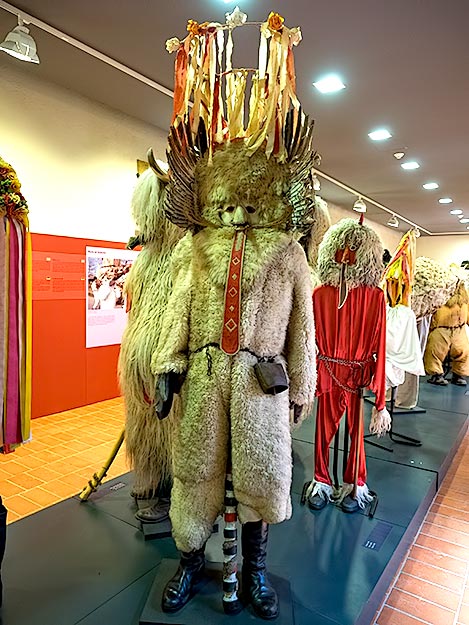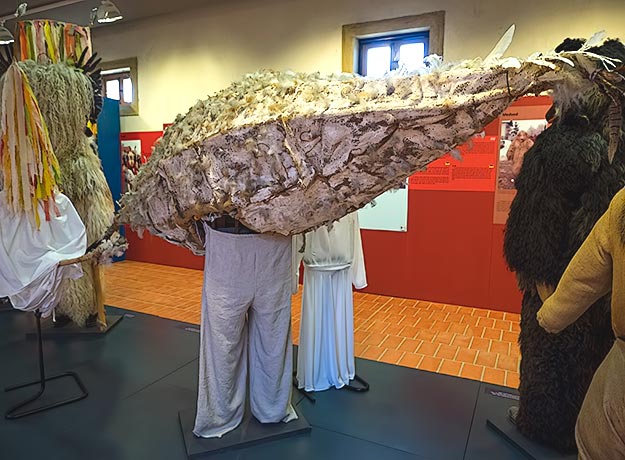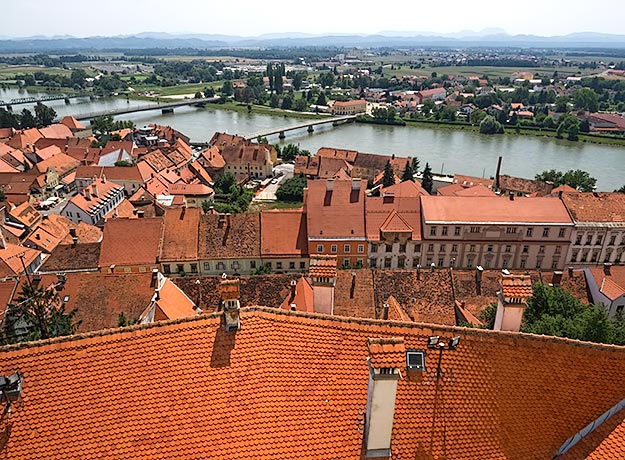The man behind the counter at Ptuj Castle suggested I begin my tour at a display of costumes and masks from Slovenian folk traditions and tales. “But I have to warn you,” he said. “Just the other day a man told me it was the scariest thing he’d ever seen.” He shook his head when I laughed. “I’m not kidding. The guy was practically shaking when he left.”

Curious, I wandered among abominable snowman-like creatures with feathered headdresses, devils with long red tongues, headless hens, and old women carrying old men in baskets strapped to their backs. Believed to assure good luck and productive crops, for centuries these scary looking magical beings were known only to rural villagers in the northeast corner of the country, especially around Ptuj, the oldest city in Slovenia. Each spring, they would make their appearance during a three-day carnival, or Kurentovanje, which commenced exactly 46 days before Easter.

The most popular carnival figure was the Korant (or Kurent), a demon who chased winter away and brought spring to the land. Korants often arrived at a local farm in a group comprised of a cracker, a collector, two or three pairs of “horses,” and a plowman. The cracker announced their arrival by cracking his whip, signaling the start of the ritual. One of the Korants would follow the “horses,” which plowed a symbolic furrow. The other Korants jumped and made horrible noises with their bells, while the plowman sowed seeds for “fat turnips.” At the end of the ceremony, the collector demanded payment in the form of food, drink, or sometimes, money. If the farmer refused, the Korants rolled on the ground and predicted an unhappy year and poor crops. Few villagers risked turning them away empty handed.

A variety of other folk characters could accompany the Korant groups. A Hudich (devil) was tasked with ensuring undisturbed round-going. Clad in black or red and wearing a frightening mask with horns, a pointed nose, and a long tongue, the Hudich menacingly brandished his pitchfork when challenged. The hen or cock character brought health to barnyard fowl. Its huge cylindrical body was made of a light framework, which was papered over and covered with feathers. A hen’s head made of wood or cardboard was attached to the front, while a tail of feathers was affixed to the back. The hen moved from house to house, accompanied by a collector.

The Rusa was believed to have an effect on the reproduction and health of cattle and horses. It stormed in on a farmyard, where a collector and a drover tried to sell the mischievous, disobedient creature to the owner of the farm. When the farmer refused, the trio wished him good luck; in return the family treated the members of the group to sausages and drinks. Gypsies, fairies, spearmen, and performing bears all had specific functions in the carnival ritual.

Slovenian folklorist France Marolt and theater director Fran Zizek arranged for these magical beings to perform for the first time in 1939 at the Festival of National Customs in Maribor. In 1960, they began performing annually in Ptuj. Over time, the legends and characters lost their magical meaning, and carnival was no longer performed in the countryside. Fortunately, the towns Ptuj, Cerkno, and Cerknica hold historically accurate carnivals each February, keeping alive this culturally significant part of Slovenian heritage.

Are you in Slovenia now? If so, drop a line. Would be great to meet up.
Interesting customs and costumes! I am originally from Romania that has many similar traditions, but these costumes look really scary. Imagine meeting someone dressed like that while you are walking peacefully on an empty road…